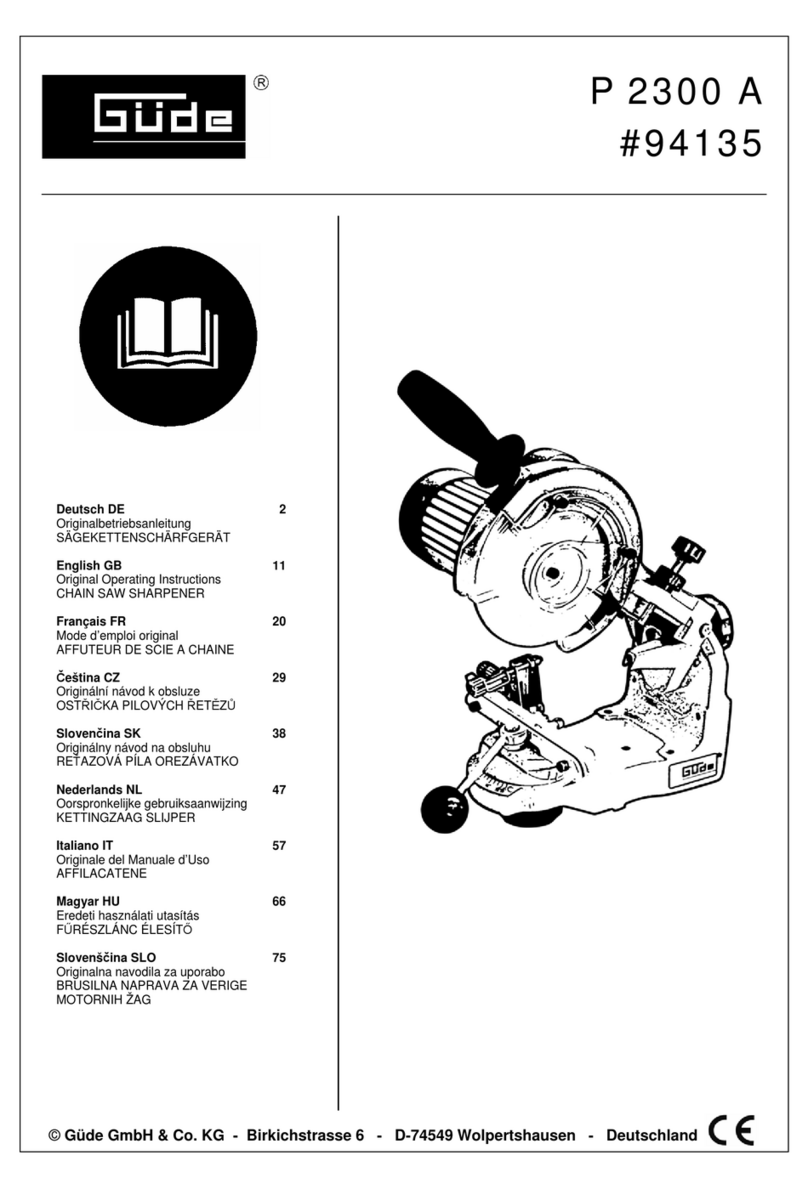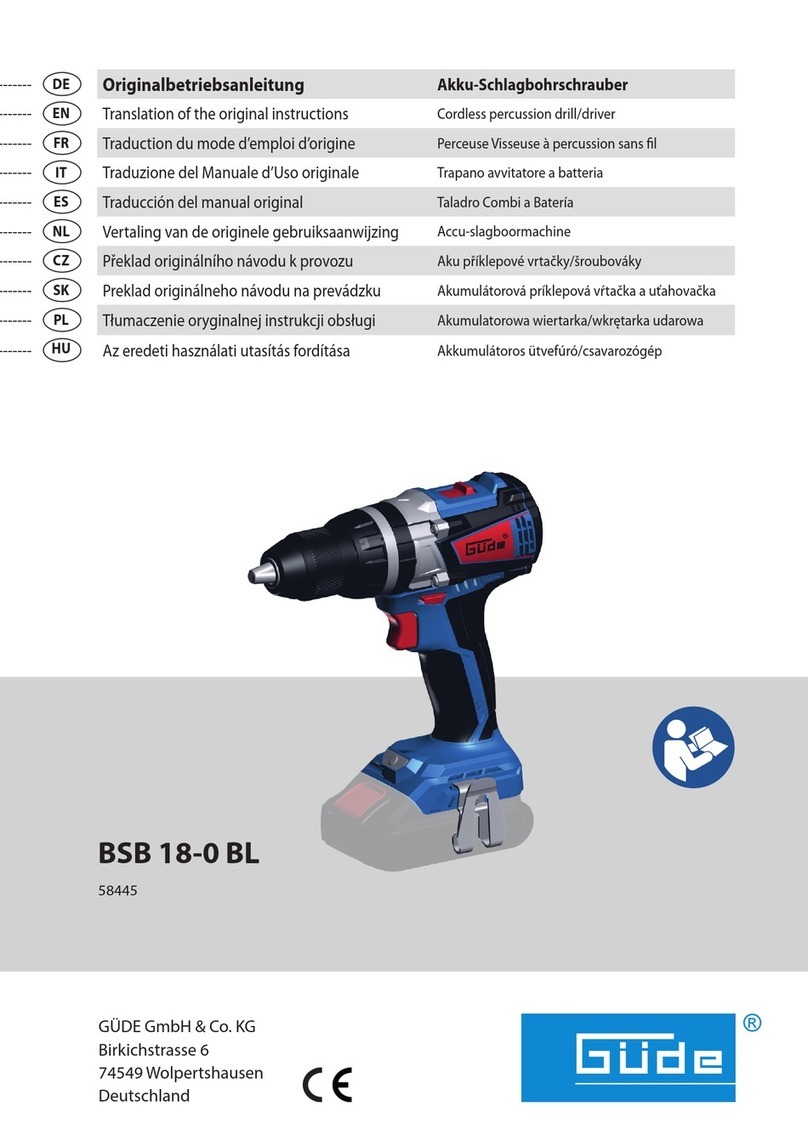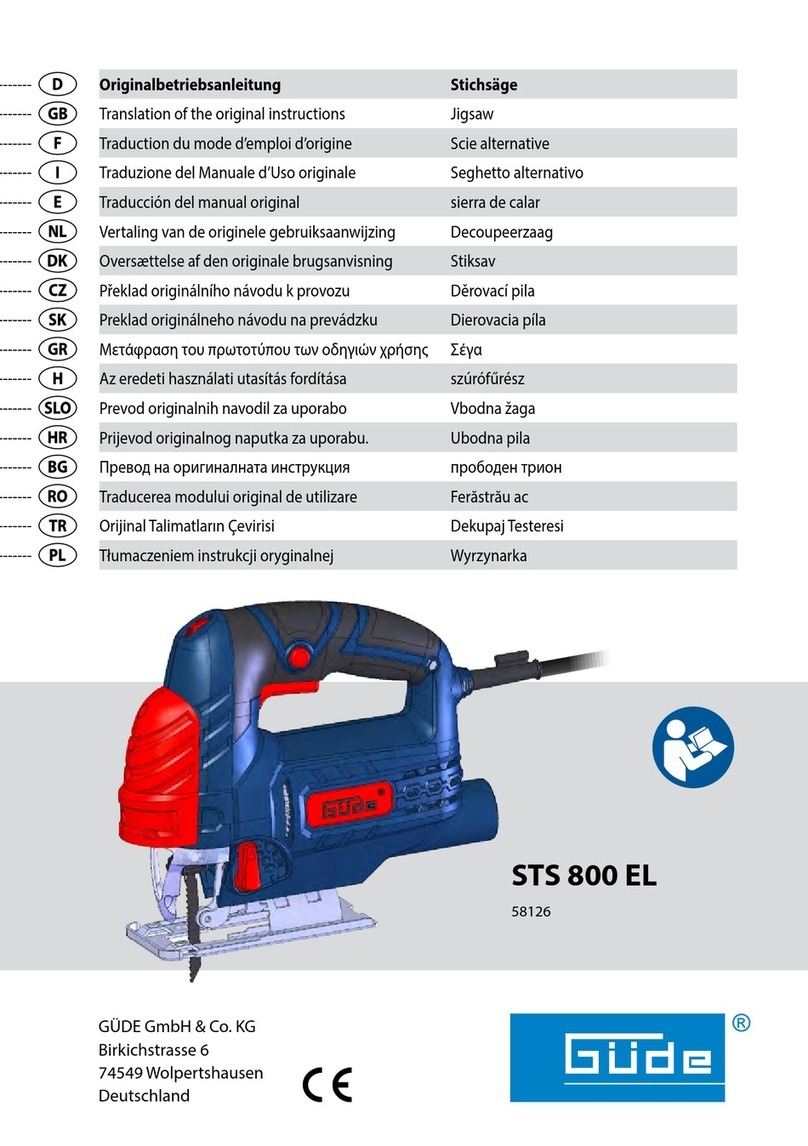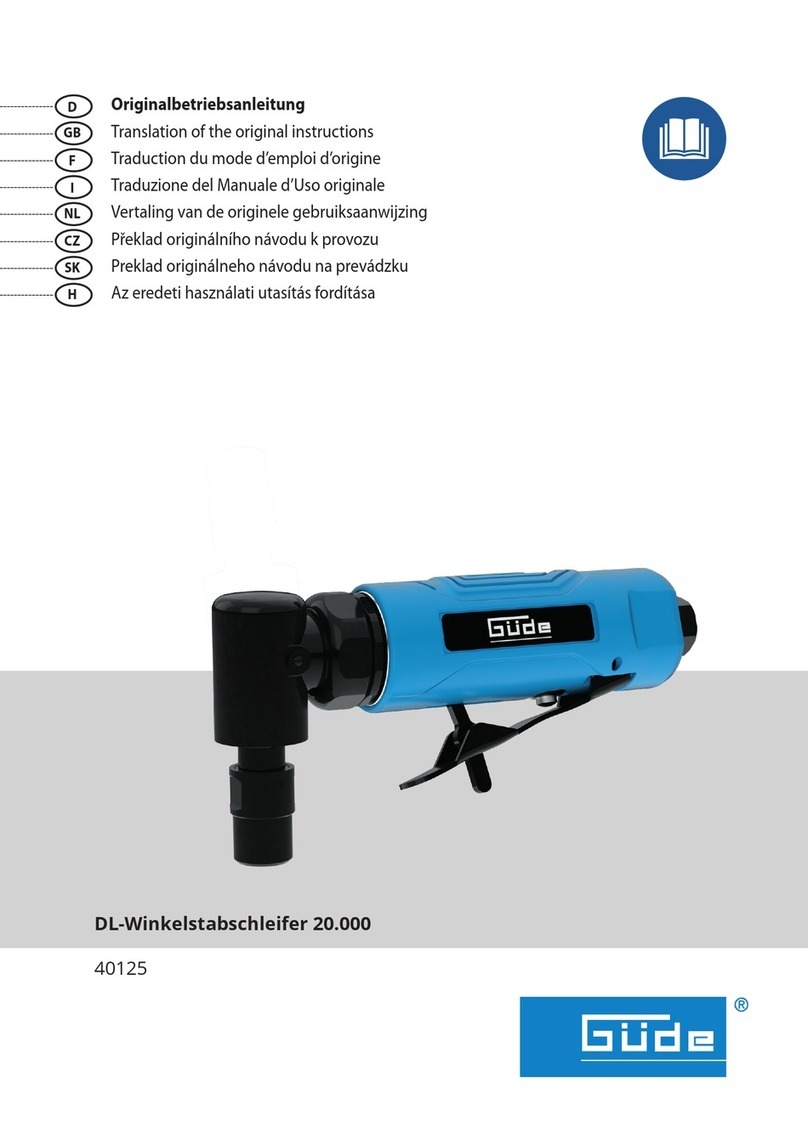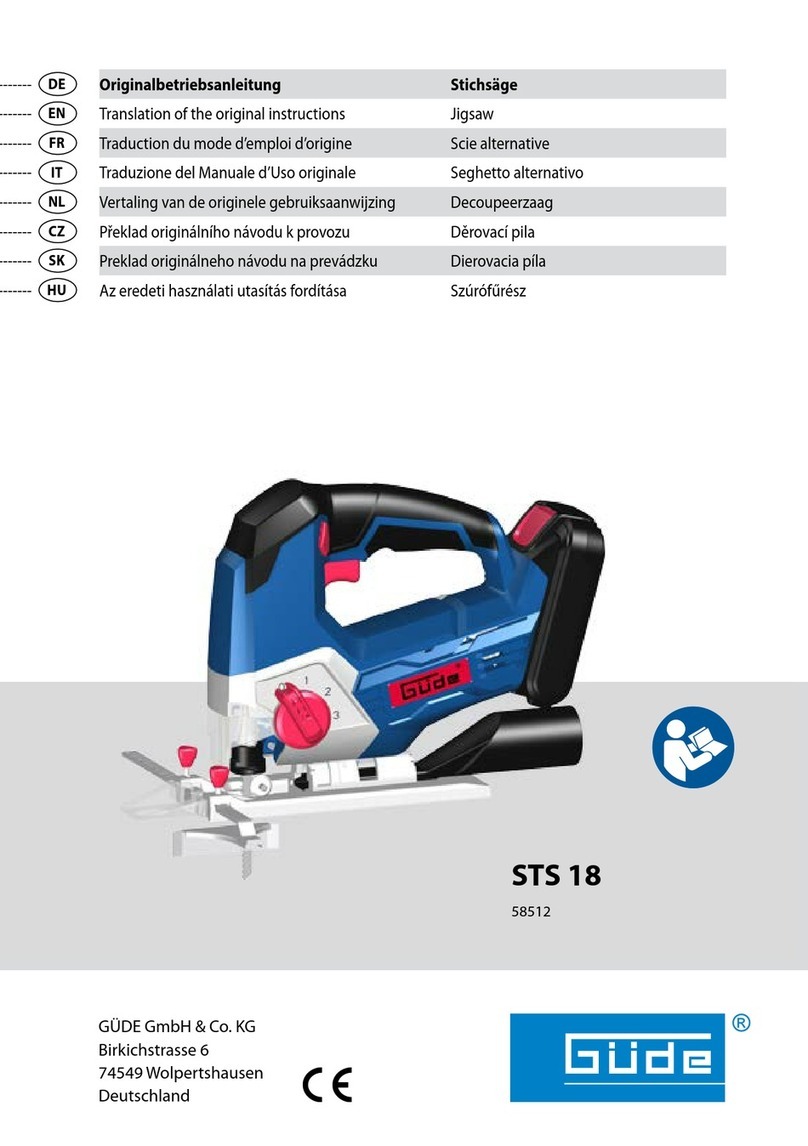
Gewährleistung
Die Gewährleistungszeit beträgt 12 Monate bei
gewerblicher Nutzung, 24 Monate für Verbraucher und
beginnt mit dem Zeitpunkt des Kaufs des Gerätes.
Die Gewährleistung erstreckt sich ausschließlich auf
Mängel, die auf Material- oder Herstellungsfehler
zurückzuführen sind. Bei Geltendmachung eines Mangels
im Sinne der Gewährleistung ist der Kaufbeleg - der das
Verkaufsdatum auszuweisen hat - mit Verkaufsdatum
beizufügen.
Von der Gewährleistung ausgeschlossen sind
unsachgemäße Nutzung, wie z. B. Überlastung des
Gerätes, Gewaltanwendung, Beschädigungen durch
Fremdeinwirkung, Fremdkörper, sowie Nichtbeachtung der
Gebrauchs- und Aufbauanleitung und normaler Verschleiß.
Allgemeine Sicherheitshinweise
Um dieses Gerät sicher betreiben zu können, sind
sämtliche Anweisungen und Informationen zu Sicherheit,
Zusammenbau und Betrieb in der Bedienungsanleitung
genau zu befolgen. Alle Personen, die diese Maschine
bedienen oder warten, müssen die Bedienungsanleitung
kennen und über potentielle Gefahren informiert sein.
Kindern sowie kranken und gebrechlichen Personen ist der
Zugang zu verwehren. Kinder sind sorgfältig zu
beaufsichtigen, wenn sie sich im Bereich von Maschinen
aufhalten. Beachten Sie die regionalen und lokalen
Unfallverhütungsvorschriften, die bei Ihnen gelten.
Dasselbe gilt für alle Bestimmungen zu Arbeitsschutz und
Gesundheit am Arbeitsplatz. Der Hersteller kann nicht
haftbar gemacht werden, wenn seine Maschinen
unerlaubterweise verändert werden und wenn aus solchen
Veränderungen Schäden entstehen. Warnung! Bei der
Verwendung von Werkzeugmaschinen sind immer
grundlegende Vorsichtsmaßnahmen zu ergreifen. Bitte
beachten Sie auch alle Tipps und Hinweise in den
zusätzlichen Sicherheitshinweisen.
UM EINEN HOHEN GRAD AN SICHERHEIT ZU
GARANTIEREN, BEACHTEN SIE AUFMERKSAM
FOLGENDE HINWEISE:
ACHTUNG!
Druckluftwerkzeuge arbeiten mit unterschiedlich hohen
Arbeitsdrücken. Der empfohlene Arbeitsdruck beträgt bei
den meisten Geräten 6 bar.
Ein größerer Druck würde aufgrund höherer Belastung die
Lebensdauer Ihres Gerätes verkürzen.
1. Lassen Sie keine Fremden an die Maschine.
Besucher und Zuschauer, vor allem Kinder sowie
kranke und gebrechliche Personen, sollten vom
Arbeitsplatz fern gehalten werden. Verhindern Sie,
dass andere Personen mit den Werkzeugen in
Berührung kommen.
2. Sorgen Sie für die sichere Aufbewahrung von
Werkzeugen. Werkzeuge, die nicht gebraucht
werden, müssen an einem trockenen, möglichst hoch
gelegenen Platz aufbewahrt oder unzugänglich
eingeschlossen werden.
3. Verwenden Sie für jede Arbeit immer das richtige
Werkzeug. Verwenden Sie z.B. keine
Kleinwerkzeuge oder Zubehör für Arbeiten, die
eigentlich mit schwerem Werkzeug verrichtet werden
müssen. Verwenden Sie Werkzeuge ausschließlich
für die Zwecke, für die sie gebaut wurden.
4. Achten Sie auf angemessene Kleidung. Die
Kleidung muss zweckmäßig sein und darf Sie beim
Arbeiten nicht behindern.
5. Tragen Sie Gehörschutz. Tragen Sie persönlichen
Schallschutz z.B. Gehörschutzstöpsel.
6. Transport des Gerätes. Sichern Sie das Gerät
gegen Umkippen, Beschädigung und Auslaufen von
Stahlgut.
7. Bleiben Sie immer aufmerksam. Achten Sie auf
das, was Sie tun. Setzen Sie Ihren gesunden
Menschenverstand ein. Verwenden Sie keine
Werkzeuge, wenn Sie müde sind. Unter dem Einfluss
von Alkohol, Drogen oder Medikamenten, die das
Reaktionsvermögen beeinträchtigen darf mit dem
Gerät nicht gearbeitet werden.
8. Achten Sie auf beschädigte Teile. Untersuchen Sie
das Werkzeug, bevor Sie es benutzen. Sind einzelne
Teile beschädigt? Fragen Sie sich bei leichten
Beschädigungen ernsthaft, ob das Werkzeug
trotzdem einwandfrei und sicher funktionieren wird.
Achten Sie auf die korrekte Ausrichtung und
Einstellung von beweglichen Teilen. Greifen die Teile
richtig ineinander? Sind Teile beschädigt? Ist alles
korrekt installiert? Stimmen alle sonstigen
Voraussetzungen für die einwandfreie Funktion?
Beschädigte Schutzvorrichtungen etc. müssen von
autorisierten Personen ordnungsgemäß repariert
oder ausgewechselt werden, sofern nicht in der
Bedienungsanleitung ausdrücklich anders erläutert.
Defekte Schalter müssen von einer autorisierten
Stelle ausgewechselt werden. Bei anfallenden
Reparaturen wenden Sie sich bitte an Ihr örtliches
Service Center.
9. Verwenden Sie nur zugelassene Teile. Verwenden
Sie bei Wartung und Reparatur nur identische
Ersatzteile. Wenden Sie sich für Ersatzteile an ein
zugelassenes Service Center.
Warnung! Die Verwendung von anderem Zubehör und
Anbauteilen, die nicht ausdrücklich empfohlen werden,
kann die Gefährdung von Personen und Objekten nach
sich ziehen.
Das Werkzeug darf nur für den vorgesehenen
Verwendungszweck benutzt werden. Jede
Zweckentfremdung wird als unsachgemäße Verwendung
betrachtet. Für Sach- und Personenschäden, die aus einer
solchen, unsachgemäßen Verwendung resultieren, ist
allein der Benutzer verantwortlich, auf keinen Fall der
Hersteller.
Der Hersteller kann nicht haftbar gemacht werden, wenn
seine Maschinen verändert oder unsachgemäß verwendet
werden und wenn daraus Schäden entstehen.
Gerätespezifische Sicherheitshinweise
•Vor Wartungs-, Inspektions- und Reinigungsarbeiten
trennen Sie die Sandstrahlkabine stets vom
Kompressor.
•Machen Sie die Bedienungsanleitung allen Personen
zugänglich, die mit der Maschine arbeiten.
•Das Gerät darf niemals mit geöffnetem Deckel
betrieben werden.
•Arbeiten Sie nur mit dem in dieser Anleitung
empfohlenen Arbeitsdruck.
•Betreiben Sie das Gerät ausschließlich mit den
montierten Handschuhen.
•Verwenden Sie nur geeignetes Strahlgut.
•Sorgen Sie immer für angemessene Beleuchtung.
•Achten Sie auf vorgeschriebene Arbeitskleidung.
•Dieses Werkzeug sollte nur von volljährigen
Personen verwendet werden. Auszubildende, die
min. das 16. Lebensjahr vollendet haben, dürfen das
Werkzeug unter Aufsicht verwenden.
•Bei der Benutzung des Gerätes sollten Kinder sowie
kranke und gebrechliche Personen fern gehalten
werden.
•Überprüfen Sie das Gerät auf Beschädigungen.
Verwenden Sie das Gerät nicht, wenn es fehlerhaft
oder beschädigt ist.
•Lassen Sie das Gerät in einem autorisierten Service
Center reparieren.


